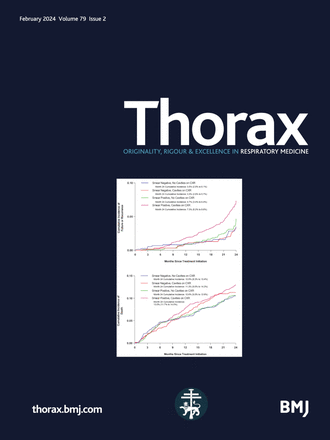The changing face of inflammation following CFTR modulation: identifying new phenotypes of innate immunity
IF 7.7
1区 医学
Q1 RESPIRATORY SYSTEM
引用次数: 0
Abstract
Triple combination therapy for people with cystic fibrosis (pwCF) restores the activity of defective cystic fibrosis transmembrane conductance regulator (CFTR) proteins. For those fortunate to receive this therapy, it has fundamentally changed the nature of the disease.1 CFTR modulators markedly improve clinical outcomes and symptoms, reversing or alleviating pathologies such as mucous plugging and overly acidic small intestine pH. However, other manifestations of disease persist (established bronchiectasis, chronic airway infections with organisms such as Pseudomonas aeruginosa ). Optimal management of pwCF depends on continued accumulation of knowledge regarding how CFTR therapy changes CF disease. 2 When the first CFTR modulator (ivacaftor) was introduced, several studies characterised how CF pathology changed following enhancement of CFTR activity3–5; however, since only a small fraction of pwCF were eligible for ivacaftor, studies were limited. The approval of elexacaftor-tezacaftor-ivacaftor (ETI) for pwCF with at least one F508del mutation meant that >90% of pwCF would be eligible for modulator therapy. Many studies were organised around the globe to capture specimens and measurements from pwCF before and after initiation of ETI. Much attention has been paid to ETI’s effects on clinical parameters and pulmonary inflammation and infection, but fewer studies have focused on the effects of ETI on systemic inflammation. In this edition of Thorax , Maher and colleagues6 describe changes in systemic inflammatory cells and …CFTR调节后炎症的变化:识别先天免疫的新表型
对囊性纤维化(pwCF)患者的三联疗法可恢复有缺陷的囊性纤维化跨膜传导调节(CFTR)蛋白的活性。对于那些有幸接受这种治疗的人来说,它已经从根本上改变了这种疾病的性质CFTR调节剂可显著改善临床结果和症状,逆转或减轻粘膜堵塞和过酸性小肠ph等病理。然而,疾病的其他表现仍然存在(已建立的支气管扩张、铜绿假单胞菌等微生物引起的慢性气道感染)。pwCF的最佳管理取决于CFTR治疗如何改变CF疾病的知识的持续积累。当第一个CFTR调节剂(活动性因子)被引入后,一些研究描述了CFTR活性增强后CF病理的变化[3 - 5];然而,由于只有一小部分的pwCF符合ivacaftor,研究是有限的。eleexactor - tezactor -ivacaftor (ETI)被批准用于至少有一个F508del突变的pwCF,这意味着大约90%的pwCF将有资格接受调节剂治疗。在ETI开始前后,在全球范围内组织了许多研究,以获取pwCF的标本和测量结果。ETI对临床参数和肺部炎症感染的影响研究较多,但对全身炎症影响的研究较少。在这一期的《胸腔》杂志中,Maher和他的同事描述了全身炎症细胞和…
本文章由计算机程序翻译,如有差异,请以英文原文为准。
求助全文
约1分钟内获得全文
求助全文
来源期刊

Thorax
医学-呼吸系统
CiteScore
16.10
自引率
2.00%
发文量
197
审稿时长
1 months
期刊介绍:
Thorax stands as one of the premier respiratory medicine journals globally, featuring clinical and experimental research articles spanning respiratory medicine, pediatrics, immunology, pharmacology, pathology, and surgery. The journal's mission is to publish noteworthy advancements in scientific understanding that are poised to influence clinical practice significantly. This encompasses articles delving into basic and translational mechanisms applicable to clinical material, covering areas such as cell and molecular biology, genetics, epidemiology, and immunology.
 求助内容:
求助内容: 应助结果提醒方式:
应助结果提醒方式:


